You are here
Giving dignity to the dead’: Naming the deceased of the 1826 ‘Lancashire Rising’
David Scott and Kate Hurst
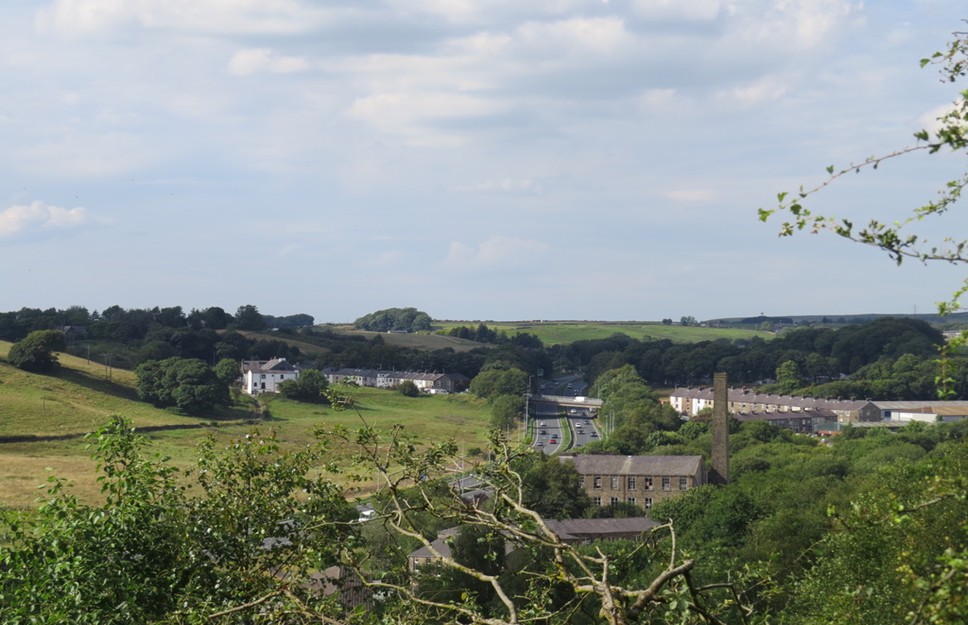
The view from Haslingden parish churchyard across the valley [Photo by Kate Hurst, 29 July 2024]
Context
The early months of 1826 in England were haunted by the devastating impact of the December 1825 economic crisis. The slump's consequences were felt across the country, and the cotton industry in Lancashire was particularly hard hit. Handloom weavers, who made up a large percentage of the workforce in Lancashire, had already experienced many years of declining wages and living standards. During the winter months of 1825/6, they began to face a real existential threat of mass starvation. In a desperate attempt to highlight their hunger and food poverty, thousands arose in protest. During the four-day uprising from the 24-27th April 1826, protestors targeted the destruction of the powerlooms to send a symbolic message to those with economic and political power that something must be done to alleviate their suffering.
Some of those who participated in this largely peaceful form of mass property destruction were to pay a heavy price. The mill owners, government and local magistracy mobilised the yeomanry, special constables, infantry, cavalry and, on one occasion, a local troop of militia with a cannon to defend the mills. With such military capabilities, alongside the little regard in which the lives of the workers were held in comparison to that of property, it was perhaps inevitable that several of the protestors paid with their lives.
The numbers killed by the soldiers during the ‘Lancashire Rising’, as well as those who protested in West Riding and Manchester in the following days and weeks, may never be fully known. Establishing their names and giving dignity to the dead is even more difficult. Whilst the names of some of those who died during the Chatterton Massacre, 26th April 1826, were reported in the newspapers at the time and have subsequently been passed down the generations to the present day, there is still much that is not widely known about those who were killed.
Several contemporary newspapers claimed there were at least three deaths in Blackburn on the 24th April 1826. Later accounts are more circumspect, but some still claim one person was killed and two seriously wounded by the Kings' Dragoons and a cavalry charge on this day. Further, several newspapers at the time claimed that three further bodies were found in the woods near Chatterton on the day following the massacre (27th April 1826). Nobody, it seems, considered it pertinent to investigate who these dead people were either at the time or through archival study. Addressing this knowledge deficit nearly two hundred years after the events is difficult. Although there are several candidates for the person/people killed in Blackburn, historical evidence is in short supply. Whilst it, therefore, may be hypothesized that 27-year-old Irish “Papist” Michael Murphy fits very well the profile of the protestors and was buried some six days after the Blackburn events on 30th April 1826, we have not yet been able to find firm evidence of how or why he died. Another candidate is Robert Isherwood, a 36 year old handloom weaver from Ramsgreave, who was buried on the same day, leaving behind a widow and seven children.
Those protestors who died of their wounds following the shootings are equally, if not more, challenging to identify. We know that some seriously wounded survived. Two such people injured on 24th April - Edward Houghton and James Howarth - both lived for at least a year after the rising. Yet, with more than 600 bullets fired into a crowd of 3,000 at Chatterton, many dozens of people were wounded that day, some seriously. As the protestors fled and hid, it is not known whether those who had been shot disappeared from the area or died of their injuries. Therefore, whilst the numbers of powerlooms destroyed are definitive (they were carefully recorded for purposes of compensation), the figures that we have on the state killings during the Lancashire Rising are likely to have been underestimated.
Naming the dead is also fraught with difficulties. The value of life, or lack of, of ordinary people at the time is perhaps illustrated by the systematic failure to name the people killed both at the time or in the period that followed. Significantly, the names of those prosecuted and sentenced at the Lancashire Assizes are all recorded. Their names were important because their punishments sent the workers a symbolic message about the power of criminal law. The names of magistrates, mill owners, and senior officers in the army who were policing the protests were all well-known (and mostly spelt correctly). They were deemed significant people. The names of those indiscriminately killed by the state, however, were not so important. Spelling errors are rife in the names of those who died – so much so that looking back today, it is not always clear which of the dead the journalists and other commentators are referring to. It is impossible to remember the dead, and say their names, if we do not know who they are.
Whilst there is evidence of other deaths linked to the Lancashire Rising, these names have remained hidden for many years; however, recent research can shine a little extra light on this. The following account, albeit still provisional, brings together all the names of those who are now known to have died during the four days of the rising and its aftermath. We name them in order of the days they were involved in the Lancashire Rising, rather than chronologically in order of the date of death. Other names may yet be added to this list, but we offer this to aid remembrance and help give the dead dignity.
Day 1: 24th April 1826
At approximately 11.00 am on 24th April 1826, a crowd of more than 1,000 people gathered at Whinney Hill, near Accrington, to hear speeches from local ‘captains’ who would lead the uprising over the next four days. Some protestors made their way north to Clitheroe, but when the crowd was met by militia and a cannon, it quickly dispersed. Many of the others, though, headed west towards Oswaldtwistle and Blackburn. A total of 415 powerlooms were destroyed in the seven mills they attacked that day.
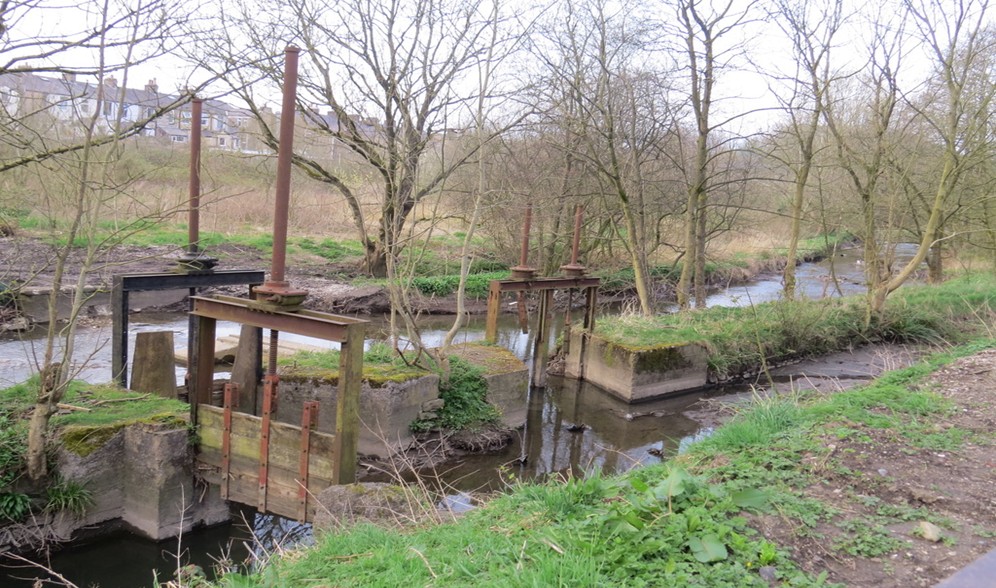
Surviving mill machinery at Primrose Mill, Clitheroe [Photo by Kate Hurst, 31 March 2021]
One of the leaders (or captains) was Simeon Wright. Aged about thirty-seven, he had been employed as a cotton spinner for at least a decade; this occupation was recorded in the registers of St. Leonard’s Church, Samlesbury on 29th May 1814, when he married Hannah Oldfield, and in 1818, their daughter Anne’s baptism record gave their address as Samlesbury Mill. Although the Wrights had at least five children, two died in infancy, and the family experienced hard times in 1822, when an order was made to send Simeon, Hannah and their two living daughters back to their home parish of Walton-le-Dale. Although it was overturned, this order demonstrates the way that the parish relief system could force those in need to leave their home and return to their birthplace, whether or not they had a current link to it. Found guilty at trial, Simeon Wright’s initial death sentence was commuted to transportation. Held on the prison hulk the Dolphin, he died on 1st March 1827. His youngest daughter, Elizabeth, was born a few days before his trial; it is unlikely he ever met her.
Day 2: 25th April 2026
At 10.00 am on the 25th April 1826, around 2,000 protestors gathered in Earcroft and marched to Lower Darwen, then onto Hoddlesden, before making their way across the rugged West Pennine Moors and down the steep slopes of Musbury Valley into the small village of Helmshore. In total, 158 powerlooms were destroyed that day. When the soldiers did arrive, 23 people were arrested and taken to the New Inn, Haslingden.
Amongst those detained was Mary Hindle. The fourth of ten children born to Giles Holden (a weaver) and his wife Mary Entwistle, she was born in October 1798 at Carrs, on the east side of Haslingden. By the time Mary married George Hindle (also a weaver) at St. James’ Church, Haslingden in July 1818, her father and two of her siblings were dead. Parish records indicate that both Mary and George were illiterate, suggesting that neither had the opportunity to go to school. Eight months later, the baptism record for their daughter Elizabeth gave their address as Club Houses. On 25th April 1826, Mary’s concern to find Elizabeth (who would have been only around six years old) took her over to Helmshore, where she became caught up in the crowds, was mistaken for a protestor, and later charged with “rioting at Musbury, and destroying power-looms, the property of William and Ralph Turner”. In spite of numerous appeals for clemency, Mary Hindle was sentenced to transportation, enduring a 138-day journey to New South Wales aboard the Harmony, with seventy-nine other passengers (including Ann Entwistle or Enwisle, another woman charged with destroying Turner’s machinery). Over a decade later, Mary absconded twice from her assigned position as a laundress, and was sent to the Female Factory in Parramatta, where she took her own life in August 1841. Mary was 5ft 2 and a quarter inch in height, had brown hair and brown eyes and, at that time (if not before), had a brown mark on the right side of her chin. She would have been around 42 when she died, some 15 years after the ‘Lancashire Rising’.
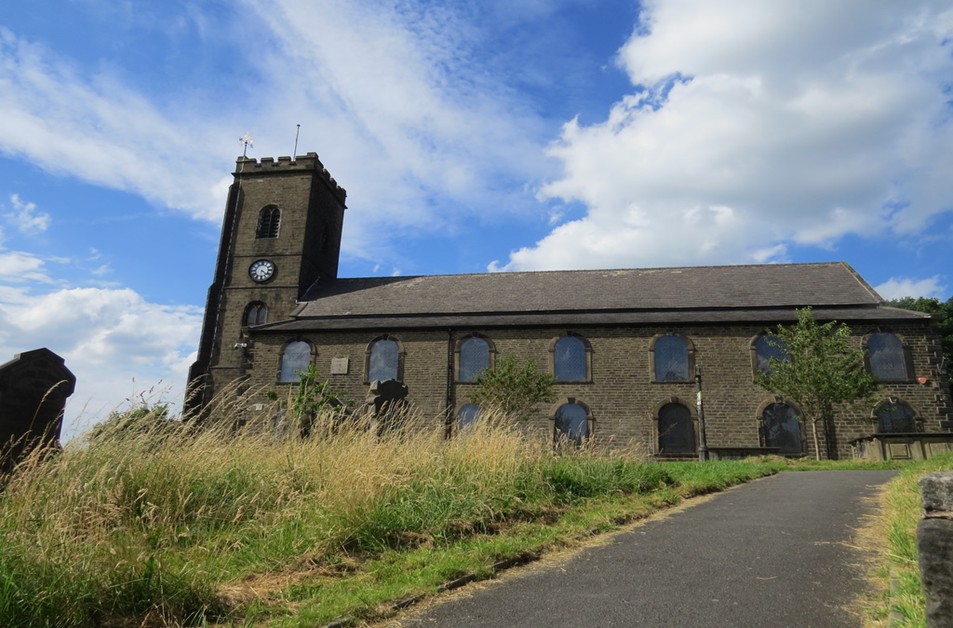
St.James C of E Church, Haslingden [Photo by Kate Hurst, 29 July 2024]
Day 3: 26th April 1826
On the morning of 26th April 1826, the powerloom destroyers made their way to mills in Rawtenstall, before setting off up the valley towards Edenfield and eventually to the mill at Chatterton. 20 sharpshooters from the 60th Duke of York’s Own Rifles fired over 600 bullets into the crowd of 3000; the names and exact number of people killed on this fateful day remain unknown. There were possibly at least nine deaths. People certainly seemed to believe so, although only six were named at the inquest.
James Lord, aged 26, was a fulling miller from Mill End, Newchurch-in-Rossendale. Possibly born at Boarsgreave (about a mile south), he had been married for just over three years. At the same moment that he threw a stone at Colonel Kearney, a senior army officer, he was struck by two musket balls; one passed through his body, the other blew the back of his head off. James was buried on 30th April 1826 at St. Nicholas with St. John, Newchurch in Rossendale; a day later, his widow Susan had their second child, Hannah, baptised at Bacup. At the inquest, James Lord’s killing was deemed justifiable homicide, and was officially recorded as ‘shot in a mob’.
John Ashworth was a 27 year old Handloom weaver from Haslingden. He may have been born at Musbury in March 1799, and was thought to be unmarried. He died after being shot in the torso outside Aikin’s Mill. John was buried on 30th April at St. James' C of E, Haslingden. It was reported in the newspapers that he had been “extremely active” in the rising. His death was held to be “justifiable homicide”, and the parish register recorded his cause of death as ‘shot in a mob’.
James Rothwell, who had just turned 23, was an unmarried handloom weaver from Hutch Bank, Haslingden. He was baptised on 10th April 1803 at St. James’ Church, to James and Betty Rothwell of Grane. He died instantly after being shot through the breast and heart. James was buried on 30th April at the same church; again, his death was recorded as ‘shot in a mob’.
Richard Lund was a 23-year-old blacksmith, who also “kept a small shop at Haslingden”. He was the second of eight children; both of his parents and at least five of his siblings were still alive in 1826. His father James was also a blacksmith; Baines’ 1824 History, Directory and Gazetteer mentions “Lund, James, Deardengate” under Blacksmiths, but there was no reference to Richard. A married man, with a young family, Richard had been involved in the destruction of powerlooms at Aikin’s mill; as he climbed out of a back window, he received a fatal wound in the stomach. Bleeding profusely, he struggled across the river Irwell, reached the bank and died, unattended, in agony. Richard was buried on 30th April 1826 at St. James', Haslingden; the parish register noted that he too was “shot in a mob”. To compound his family’s grief, his infant daughter died a few weeks later.
Mary Simpson, aged 23, was the wife of a weaver from Clough End, Haslingden. That morning, Mary had made her way to Edenfield, near Chatterton, intending to catch the coach to Manchester. Not expecting the 3,000-strong crowd that gathered, she was delayed, and the coach left without her. Whilst waiting for the next coach she was “standing on a hill at a short distance from the factory” in Chatterton. As the soldiers dispersed the crowd she was shot in the left thigh, possibly by a stray shot or a ricochet, and bled to death. Although Mary Simpson was merely a bystander, in the days following the massacre, there were claims that she was actively involved in the protests. The Inquest verdict was ‘Accidental death’, but a note next to Mary’s burial record read, “Shot in a mob”. Her funeral, at St. James', Haslingden, took place on 30th April, performed by the same vicar who conducted her wedding four years earlier.

Walmsley Unitarian Chapel, Egerton, the place where James Waddacre was baptised [Photo by Kate Hurst, 12 September 2024]
James Waddacre, aged 40, was from Alderbottom, near Ramsbottom, and had family connections to the area between Darwen and Bolton. In 1826, he was married with a teenage son, and employed as a dresser at Lawrence and John Rostron’s cotton mill at Dearden Clough, Edenfield. James was shot dead at close range by one of the soldiers attempting to enter No. 12 Chatterton Cottages, the dwelling of his friend Mrs. Betty Upton. He bled to death on the doorstep a few minutes later. James Waddacre was buried on 30th April 1826 at Emmanuel Church, Holcombe. His was the only death at Chatterton recognised as “wilful murder against a rifleman unknown”.
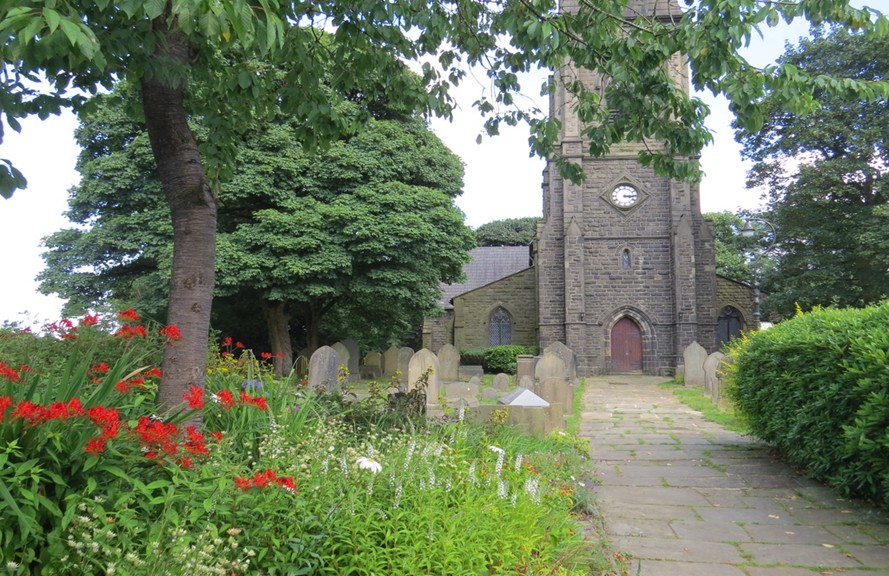
Emmanuel Church, Holcombe, the burial place of James Waddacre [Photo by Kate Hurst, 29 July 2024]
There was, however, at least one further death linked to day three. Thomas Ashworth was a 27 year-old labourer living “near Bacup” (alternatively described as a carter from Rawtenstall) when he was charged - alongside two younger women - with rioting at Lower Booths, and destroying machinery at the Whitehead brothers’ factory. Held in Burnley before being moved to Lancaster Castle on 3rd May 1826, his initial death sentence was commuted to three months’ imprisonment on 8th September, but Thomas never left Lancaster alive. His death on 26th September 1826 was attributed to a “visitation of God” (unexplained cause). Perhaps unusually, it appears that his family claimed his body; he was buried at St. Nicholas and St. John C of E Church, Newchurch in Rossendale on 1st October 1826.
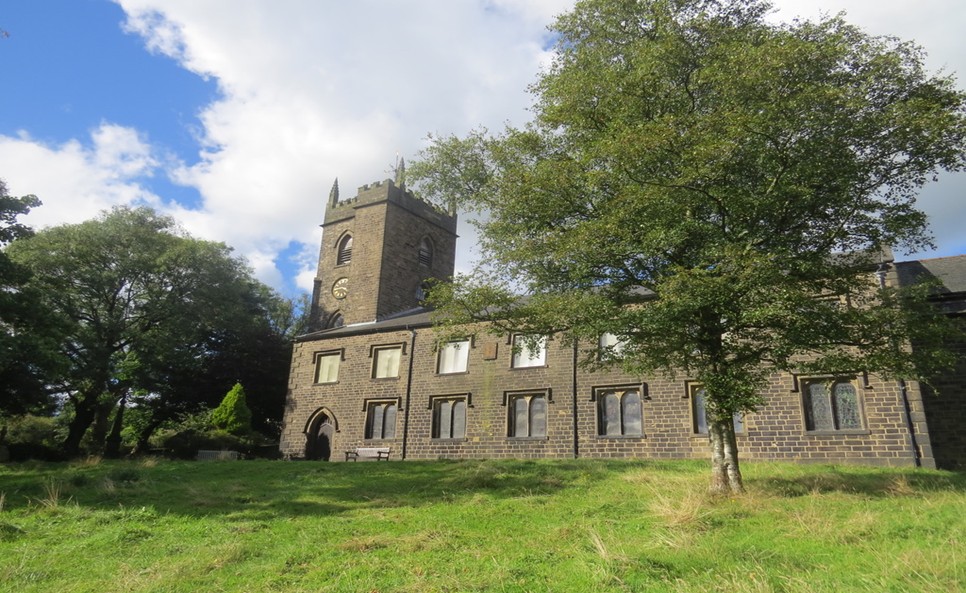
St. Nicholas and St. John’s C of E Church, Newchurch in Rossendale, the burial place of James Lord and Thomas Ashworth [Photo by Kate Hurst, 12 September 2024]
Day 4: 27th April 1826
The fourth day started in Tockholes, near Darwen, where protestors made their way to Water Street Mill, via the fields and back roads. The leaders were now wanted men and needed to avoid the troops and special constables charged with arresting them. James Chambers, who had also been a leader on the first day, was one of the captains. When he was eventually caught he was charged with “rioting” at Blackburn and Chorley.
Aged about 55, James Chambers was considerably older than the majority of people arrested. A widowed farmer from Oswaldtwistle, he had lived at Top and Ramsclough during the late eighteenth century, and parish registers suggest that, by 1826, he had at least three grandchildren. Charged with destroying machinery at the Houghton factory, and Bannister Eccles’ factory in Blackburn on 24th April, and with similar offences at George Hilton’s factory in Chorley, he was described by the English Chronicle and Whitehall Evening Post (17th August 1826) as “one of the most violent of the rioters”, and when confronted by soldiers, reportedly protested, “What, are we all to be clamed?” (A dialect word, meaning starved with hunger.) He was sentenced to transportation, and transferred to the prison hulk Dolphin, where he was held with at least seven others involved in the uprising - including Simeon Wright - but did not board the Manlius when it sailed to Australia. James Chambers died on 7th May 1827. Presumably he, like Simeon Wright, died whilst still on board the Dolphin hulk ship.
Say Their Names
The people we have named above are almost certainly not the only ones who died as a consequence of the legal repression of the rising. Nor were they the only avoidable and premature deaths resulting from years of declining living standards and the 1825 economic collapse. Thousands died of food poverty and hunger in the years that followed. Yet, despite these terrible harms that befell the people of Lancashire, the courage of those who engaged in (or, indeed, merely observed) the rising and lost their lives should never be forgotten. There is an ethical responsibility to ensure those who die in struggles for freedom, rights and justice and helped to secure the kind of living standards we take for granted today are appropriately remembered. In the name of dignity, we must ensure we continue to know and say the names of the dead.
